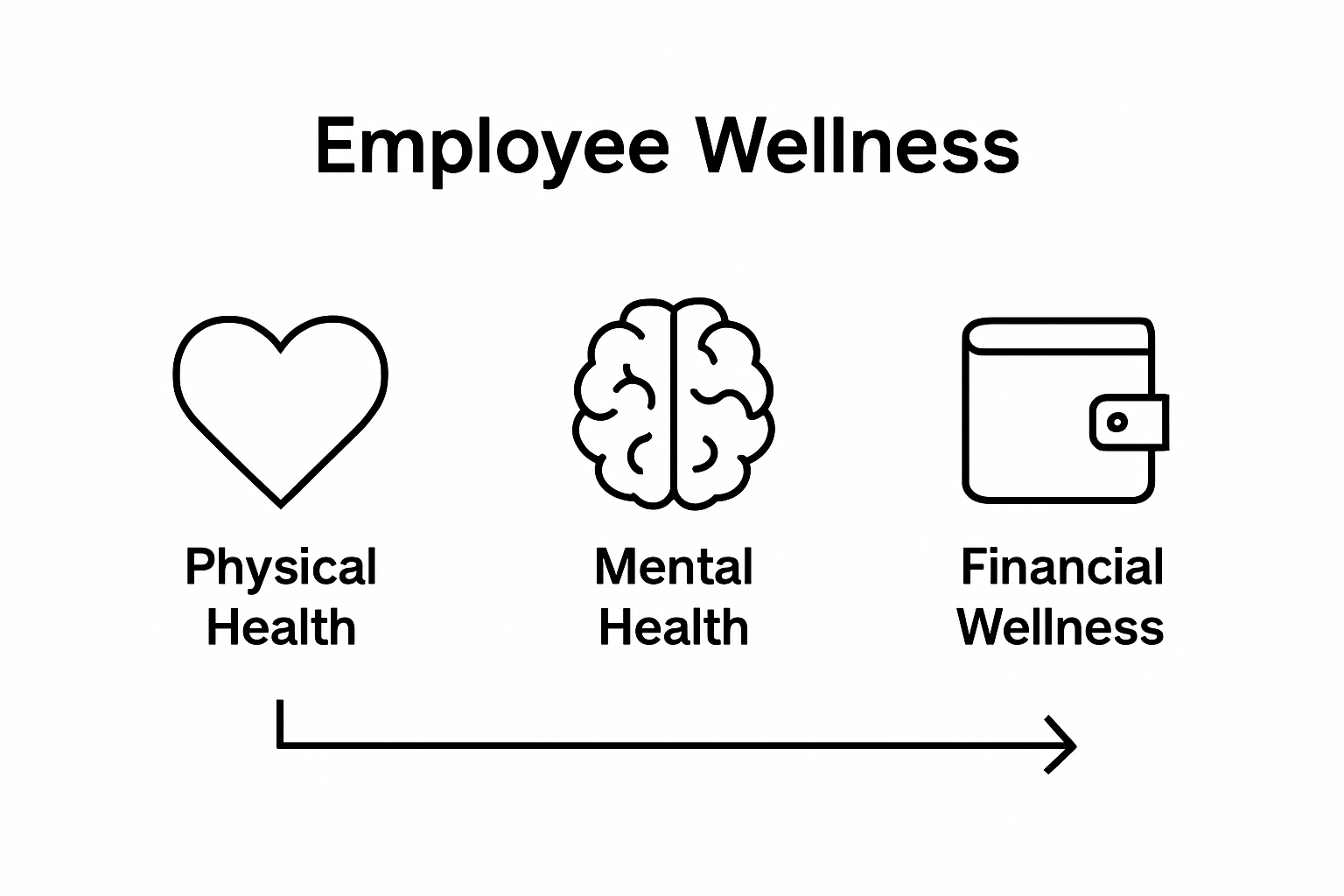Understanding Employee Wellness Programs and Their Benefits

Workplace health is getting a major upgrade and organizations are moving far beyond gym memberships and annual check-ups. Employers now craft wellness programs that tackle everything from stress to nutrition to financial worries. But those yoga classes are just the surface. Companies with strong wellness programs see real results, like higher employee loyalty and increased job satisfaction. Turns out the biggest win is a thriving, motivated team that feels genuinely supported at work and ready to take on any challenge.
Table of Contents
- What Are Employee Wellness Programs?
- Why Employee Wellness Programs Matter
- How Employee Wellness Programs Function
- Key Concepts of Employee Wellness Programs
Quick Summary
| Takeaway | Explanation |
|---|---|
| Invest in comprehensive wellness programs | Holistic employee wellness programs enhance health and reduce costs for organizations. |
| Promote mental health and emotional well-being | Addressing mental health is crucial for employee satisfaction and productivity. |
| Utilize personalized assessments for effective planning | Tailored health assessments allow for focused and relevant wellness interventions. |
| Create a positive workplace culture | Wellness initiatives improve engagement, loyalty, and job satisfaction among employees. |
| Focus on prevention and early intervention | Proactive approaches can help mitigate health issues before they escalate. |
What Are Employee Wellness Programs?
Employee wellness programs are comprehensive strategies designed to support and improve the overall health and well-being of workers within an organization. These holistic initiatives go beyond traditional healthcare benefits by addressing physical, mental, and emotional aspects of employee health.
Defining Wellness Program Components
At their core, employee wellness programs represent a strategic investment in workforce health. These programs typically include a range of services and resources aimed at promoting healthier lifestyle choices and preventing potential health issues.
To give a clearer overview of the typical components found in comprehensive employee wellness programs, the following table summarizes the major features and their descriptions.
| Component | Description |
|---|---|
| Physical Health Screenings | Evaluations to detect health risks and assess general physical well-being. |
| Mental Health Support | Counseling and resources to address emotional and psychological needs. |
| Fitness and Exercise Programs | Structured physical activity opportunities for employees. |
| Nutrition Guidance | Educational resources and personalized plans for healthier eating. |
| Stress Management Workshops | Sessions focused on managing workplace and personal stress. |
| Financial Wellness Education | Tools and classes aimed at improving financial literacy and reducing financial stress. |
Key components of comprehensive employee wellness programs often encompass:
- Physical health screenings and assessments
- Mental health support and counseling services
- Fitness and exercise programs
- Nutrition guidance and dietary resources
- Stress management workshops
- Financial wellness education
Understanding Program Objectives
The primary goals of employee wellness programs extend far beyond simple health interventions. Organizations implement these programs to create a supportive work environment that demonstrates genuine care for employee well-being. Harvard Business Review suggests that successful wellness initiatives can significantly reduce healthcare costs, improve employee productivity, and enhance overall organizational performance.
By addressing multiple dimensions of health, these programs aim to cultivate a workplace culture that values employee holistic wellness. This approach recognizes that employees are more than just workers - they are individuals with complex physical, emotional, and professional needs. Through thoughtful, integrated wellness strategies, companies can create environments that support sustainable employee health and organizational success.
Why Employee Wellness Programs Matter
Employee wellness programs represent more than just a corporate trend. They are strategic investments that deliver substantial benefits to both organizations and workers, addressing critical challenges in modern workplace environments.
Economic and Productivity Impact
The financial implications of implementing employee wellness programs are significant. American Journal of Health Promotion research indicates that comprehensive wellness initiatives can generate substantial returns on investment. Companies investing in employee health experience measurable economic advantages through reduced healthcare expenditures and increased workforce productivity.
Key economic benefits include:
- Decreased healthcare insurance premium costs
- Reduced employee absenteeism
- Enhanced overall organizational performance
- Improved employee retention rates
- Minimized long-term health-related expenses
Employee Engagement and Workplace Culture
Wellness programs fundamentally transform workplace dynamics by demonstrating genuine organizational commitment to employee well-being. These initiatives signal that employers value their workforce beyond mere transactional work relationships.
To organize the key economic and cultural benefits discussed, this table outlines the main organizational impacts of employee wellness programs and how they contribute to a stronger workplace.
| Benefit | Explanation |
|---|---|
| Reduced Healthcare Costs | Fewer claims and lower insurance premiums due to healthier workforce. |
| Increased Productivity | Healthier employees can focus better and miss fewer workdays. |
| Improved Retention Rates | Supportive programs promote loyalty and decrease turnover. |
| Enhanced Workplace Culture | Wellness initiatives foster a positive, engaged environment. |
| Competitive Talent Attraction | Organizations with wellness programs are more attractive to job seekers. |
Moreover, wellness programs contribute to creating a positive workplace culture that attracts top talent. In an increasingly competitive job market, organizations that prioritize holistic employee health gain a significant competitive advantage. By addressing physical, mental, and emotional wellness, companies can build resilient, motivated workforces capable of adapting to complex professional challenges.
Through strategic wellness investments, organizations can cultivate environments where employees feel genuinely cared for, leading to increased motivation, creativity, and overall workplace satisfaction.
How Employee Wellness Programs Function
Employee wellness programs operate through carefully designed, multifaceted approaches that systematically address individual health needs while aligning with organizational objectives. These comprehensive systems integrate various strategies to promote holistic employee well-being.
Assessment and Personalization
RAND Corporation research highlights that effective wellness programs begin with comprehensive health assessments. These initial evaluations help organizations understand individual employee health profiles, enabling targeted interventions tailored to specific needs.
Typical assessment components include:
- Comprehensive health risk questionnaires
- Biometric screenings
- Physical fitness evaluations
- Mental health assessments
- Lifestyle and behavioral analysis
Program Implementation Strategies
Once individual health profiles are established, organizations design multidimensional wellness initiatives. These programs typically combine educational resources, behavioral interventions, and incentive structures. Successful implementations often integrate digital platforms, allowing employees to track progress, participate in challenges, and access personalized health recommendations.
Employer strategies frequently involve creating structured wellness pathways that include:
- Regular health education workshops
- Digital tracking and monitoring tools
Incentive and Engagement Models
To drive participation, wellness programs utilize sophisticated engagement models. These typically involve providing meaningful incentives that motivate employees to actively participate in health improvement activities. Incentives might range from reduced health insurance premiums to financial bonuses, creating a positive reinforcement mechanism that encourages sustained healthy behaviors.
The most effective programs recognize that wellness is not a one-size-fits-all approach. By offering flexible, personalized pathways and maintaining a supportive, non-judgmental environment, organizations can successfully transform wellness from a corporate initiative to a genuine employee-centric experience.
Key Concepts of Employee Wellness Programs
Employee wellness programs are sophisticated frameworks built upon fundamental principles that transcend traditional healthcare approaches. These strategic initiatives represent a holistic understanding of employee health and organizational performance.
Comprehensive Health Perspective
National Institutes of Health research highlights the importance of viewing employee wellness through a multidimensional lens. Wellness is not merely the absence of disease, but a dynamic state of physical, mental, and social well-being. Modern programs recognize that employee health encompasses interconnected domains of personal and professional experience.
Core dimensions of this comprehensive health perspective include:

- Physical health and fitness
- Mental and emotional well-being
- Financial wellness
- Social and interpersonal health
- Professional development and stress management
Preventative and Proactive Approach
Unlike reactive healthcare models, employee wellness programs emphasize prevention and early intervention. These initiatives aim to identify potential health risks before they develop into significant challenges. By providing resources, education, and support, organizations can help employees make informed health decisions.
Preventative strategies typically involve:
- Regular health screenings
- Risk assessment tools
- Early intervention programs
- Health education workshops
Personalization and Individual Empowerment
Successful wellness programs recognize that each employee has unique health needs and challenges. Personalization is key to engaging workers and driving meaningful health outcomes. By offering flexible, tailored approaches, organizations can create wellness experiences that resonate with individual employees.
This personalized approach transforms wellness from a corporate mandate to an empowering, individual journey of health improvement and personal growth. Through thoughtful, adaptive strategies, employee wellness programs can create environments that genuinely support worker well-being and organizational success.

Take the Next Step in Employee Wellness – Choose Sustainable Solutions That Reflect Your Company Values
As highlighted in “Understanding Employee Wellness Programs and Their Benefits,” implementing holistic wellness strategies is not just about health screenings or fitness perks. It is also about showing genuine care for your team by shaping a supportive workplace environment and making responsible choices that benefit both people and the planet. Forward-thinking organizations know that every detail matters—including the products employees and guests use every day.

Show employees you value their full well-being and reinforce your company’s commitment to a healthier workplace culture by making sustainable choices. Our plant based and compostable straws align perfectly with wellness goals and create visible proof of your organization’s dedication to positive change. Make your next step toward a healthier, happier workforce by visiting theoceanstraw.com today. Start leading by example—choose options that support wellness for your team and our environment.
Frequently Asked Questions
What are employee wellness programs?
Employee wellness programs are comprehensive strategies designed to support and improve the overall health and well-being of employees by addressing physical, mental, and emotional aspects of health.
What are the main components of a wellness program?
Key components of wellness programs typically include health screenings, mental health support, fitness programs, nutrition guidance, stress management workshops, and financial wellness education.
How do employee wellness programs benefit organizations?
Wellness programs can significantly reduce healthcare costs, improve employee productivity, enhance retention rates, and contribute to a positive workplace culture that attracts top talent.
How can organizations ensure participation in wellness programs?
Organizations can drive participation by utilizing incentives such as reduced health insurance premiums or financial bonuses, as well as offering personalized wellness pathways and maintaining a supportive environment.